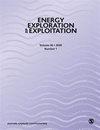Discussion on the production mechanism of deep coalbed methane in the eastern margin of the Ordos Basin
IF 1.6
4区 工程技术
Q4 ENERGY & FUELS
引用次数: 0
Abstract
This study builds upon the research progress in the theories of CBM desorption, diffusion, and seepage flow to explore the production mechanisms of deep coalbed methane (CBM) in the Daing-Jixian block, aiming to achieve scientific and reasonable control of gas wells. Theoretical analysis suggests that CBM adsorption belongs to liquid–solid interfacial adsorption, encompassing four stages: liquid phase adsorption—liquid phase desorption—composite desorption—gas phase desorption. Most of the desorbed gas is driven by a pressure differential in a Darcy's flow process. By calculating the Knudsen number (Kn) under various temperature, pressure, and fracture diameter conditions, the flow state can be identified. Whole-diameter CT scanning reveals a multi-scale pore-fracture system ranging from millimeters to micrometers to nanometers. Calculations show that during the gas well drainage and depressurization process, fractures of millimeter scale and larger exhibit Darcy's flow, while micron-scale fractures maintain Darcy's flow status above a reservoir pressure of 5 MPa; other scales primarily exhibit non-Darcy flow without significant macroscopic movement. In summary, starting from the fundamental mechanisms of the original multiscale tri-level pore-permeability system of the coal reservoir, through the post-fracturing transformation forming three diversion zones of high, medium, and low conductive regions, and transitioning from primarily free gas to desorbed gas in three production stages, an ideal comprehensive production model schematic for the study area has been established, providing theoretical support for on-site production management.鄂尔多斯盆地东缘深层煤层气生产机理探讨
本研究在煤层气解吸、扩散和渗流理论研究进展的基础上,探讨了大英吉县区块深层煤层气的生产机理,旨在实现气井的科学合理控制。理论分析表明,煤层气吸附属于液固界面吸附,包括液相吸附-液相解吸-复合解吸-气相解吸四个阶段。在达西流过程中,大部分解吸气体由压差驱动。通过计算不同温度、压力和裂缝直径条件下的努森数(Kn),可以确定流动状态。全直径 CT 扫描显示了从毫米、微米到纳米的多尺度孔隙-裂缝系统。计算表明,在气井排水和减压过程中,毫米及以上尺度的裂缝表现为达西流,而微米尺度的裂缝在储层压力达到 5 兆帕以上时保持达西流状态;其他尺度的裂缝主要表现为非达西流,没有明显的宏观运动。综上所述,从煤储层原始多尺度三层孔隙渗透系统的基本机理出发,通过压裂后形成高、中、低三个导流区的转化,以及从游离气为主过渡到解吸气为主的三个生产阶段,建立了研究区理想的综合生产模型示意图,为现场生产管理提供了理论支持。
本文章由计算机程序翻译,如有差异,请以英文原文为准。
求助全文
约1分钟内获得全文
求助全文
来源期刊

Energy Exploration & Exploitation
工程技术-能源与燃料
CiteScore
5.40
自引率
3.70%
发文量
78
审稿时长
3.9 months
期刊介绍:
Energy Exploration & Exploitation is a peer-reviewed, open access journal that provides up-to-date, informative reviews and original articles on important issues in the exploration, exploitation, use and economics of the world’s energy resources.
 求助内容:
求助内容: 应助结果提醒方式:
应助结果提醒方式:


